As the condor glides it’s 30km between Pissis and Bonete, the Andes’ third and fourth highest peaks. By road it’s more like 600km. But one of the advantages of the easy angled, rolling Puna is that it’s possible to pick a route between two points from satellite pictures and then just go cross-country. There’s no danger of encountering a raging, unfordable river or an impassable ravine.
From the north side of Pissis we wound our way into a shallow quebrada, then pushed, and at times carried, our bikes for a day and a half to a 5650m pass. The descent led us into a valley so pristine and remote that we could well have been convinced it had never before been trodden by man. Except that we were continually coming across footprints in the sand from a group of Poles who’d made a rare ascent of Bonete from the north the week before.
Another day and a half of pushing saw us reach the 4×4 tracks to Corona del Inca, and these we followed to the base of Bonete. The summit morning was bone chillingly cold, but at the top the sweeping panoramas made up for numb hands and frozen noses. All the pushing had sapped our energy however, so we were sluggish on this climb, finding it more tiring than any of our previous ascents.
The following day we took a poorly planned route, which needlessly crossed many ridges, to the base of Veladero, the last of the peaks on our Puna 9 adventure. By this time our energy had returned and in the morning we climbed quickly from a 5200m camp to the Inca ruins on the summit. Our ninth successful ascent this season! All thirteen 6400ers on the Puna climbed!
Two months ago we thought our chances of achieving this ambitious goal were slim, but some good acclimatization, plenty of sweat, and a bit of help from Pachamama with the weather, and we’d done it! And, more importantly, we’d enjoyed it too. No disillusionment, or wishing we hadn’t set such an arduous goal.
Nonetheless, on the two day cruise down to Villa Union we couldn’t help feeling glad that we were done with the inhospitable Puna for now. No more mushy pasta or drinking of dish water. It was time for ice cream and steak, wine and a shower. A bit of a rest and then more plans to return to this incredible area will no doubt begin to be hatched.
But that’s for the future. For now it’s time to begin our journey back to Huaraz and that other Andean love of ours – the Cordillera Blanca.
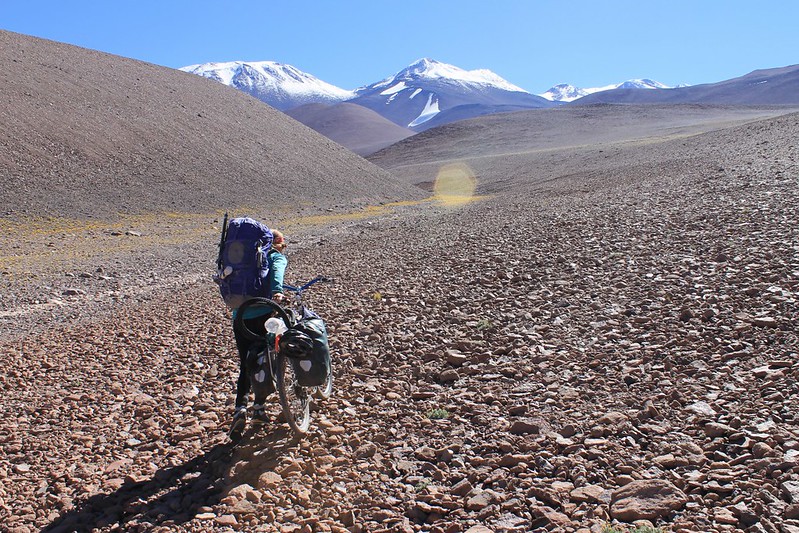
The push to Bonete begins easily enough. Arriving back at our bikes from Pissis high camp at 16:00 we push for a few hours from 4400m to a camp at 4600m.

This 20m descent into the valley which goes right up to the pass we’re headed for is the only time in the day and a half of pushing that we’re not climbing.
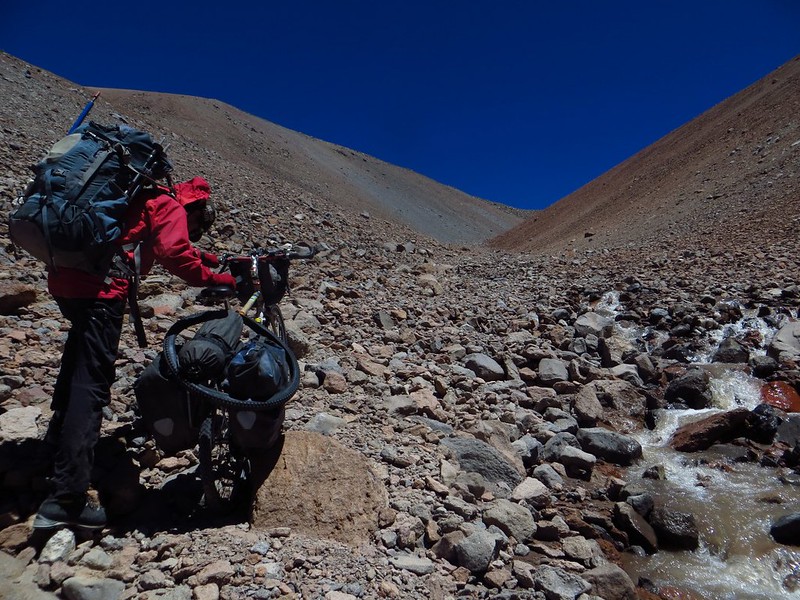
The going remains easy to 5000m. Then the gradient steepens, the terrain becomes more rocky and it takes us all afternoon to get up to 5300m and our next camp.

As usual on such terrain, Pike soon begins ferrying kit, while Haz continues struggling up with backpack on and loaded bike.
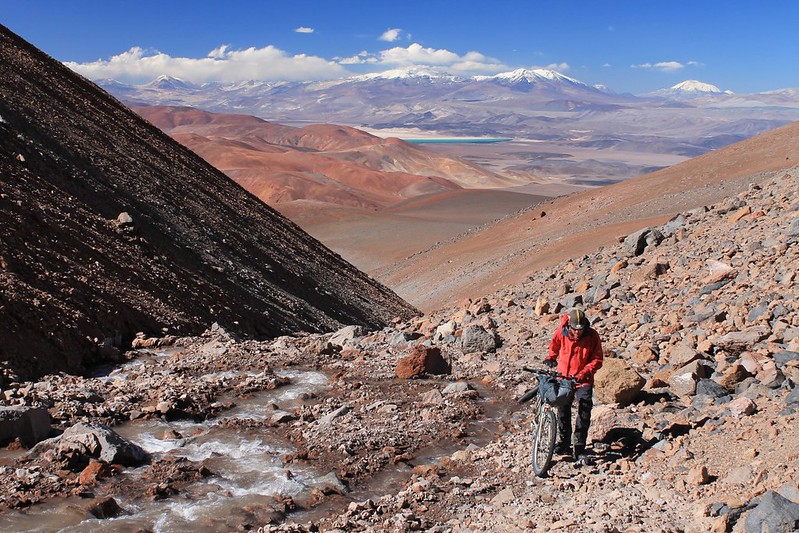
But eventually it becomes easier. By this time we were tired though, so soon after this shot we camped…
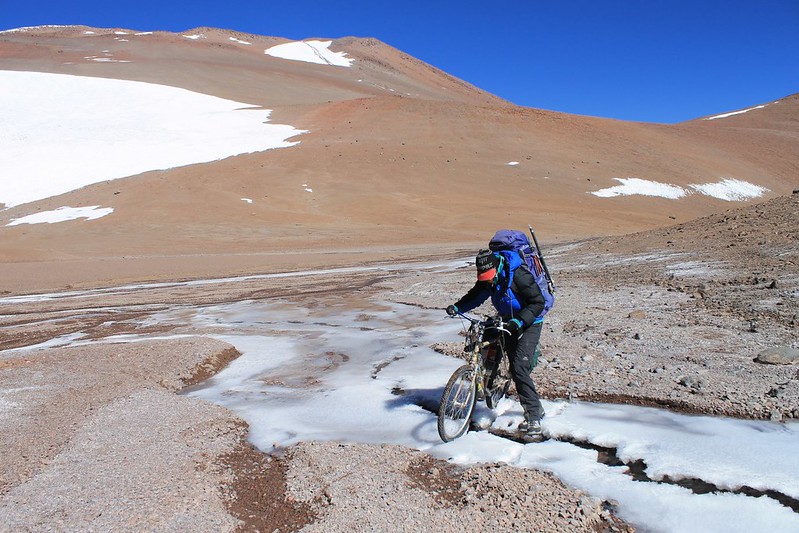
In the morning it’s easy again. Though we’re still carrying 11 days of food our kit isn’t that heavy as we don’t need to carry any water. Plenty of that, in its various forms, around.

We finally reach the pass, and mark it like dogs. Well, with a spare spoke and some of Jonson’s ribbon, anyway.
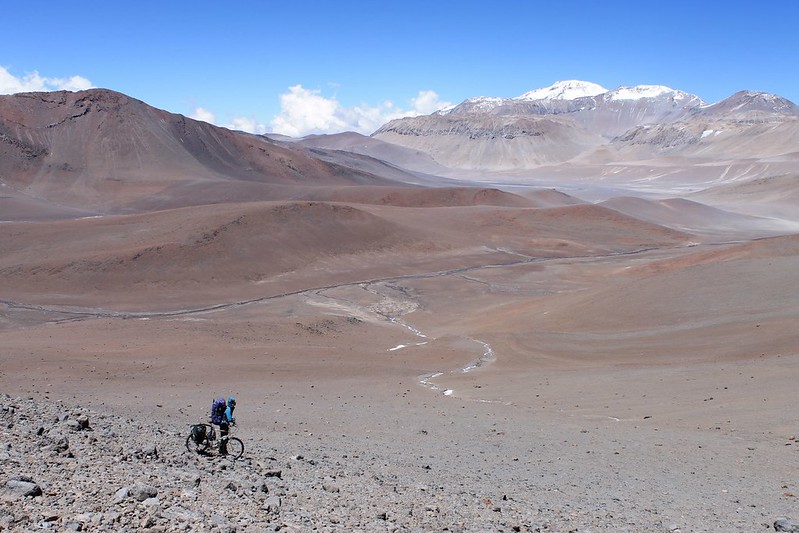
The descent isn’t tricky. Bonete looms ahead, but we have to veer west for the rest of the day, to find a way up toward Corona del Inca.

The weather since we left Fiambala had been perfect to this point, but on day 9 we wake to ominous clouds. We pack up camp quickly, to try and get to the 4×4 tracks to Corona del Inca before the snow arrives.

Then it flattens off, and but for a few quebradas we have to descend into and then climb out of it’s easy enough to the 4×4 tracks.

In the morning we enjoy a coffee treat. Probably need to try and clean that Nalgene bottle a bit better…

The 4×4 track isn’t in great condition in places. Not quite sure how the vehicles get through this bit.

Though there’s lots of sand around, the wet bed of the Rio Veladero makes for a harder, rideable surface.
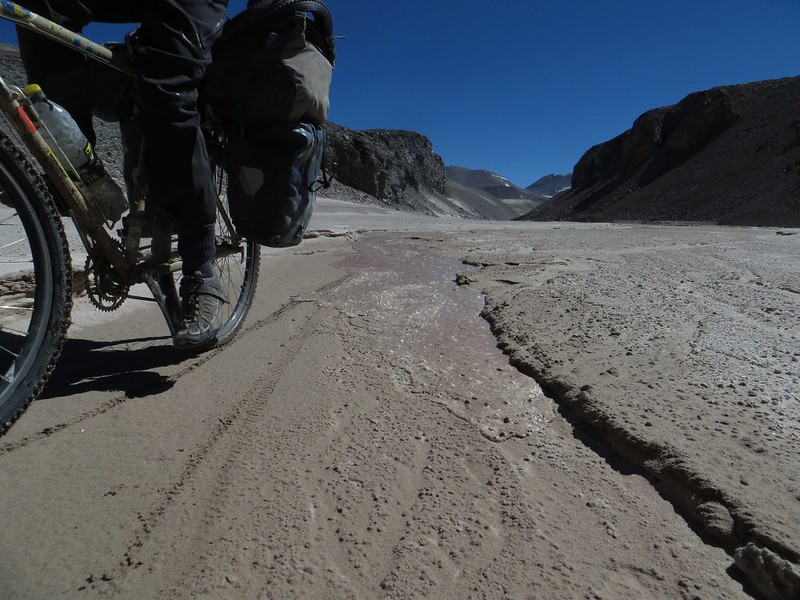
The stream dries up every evening, then starts up again in the morning as the penitentes begin to melt. Here we are outrunning it…

In the morning we’re climbing in a shadowy gulley for a few hours. It’s bloody cold, so we detour a bit off route to warm hands in the sun.
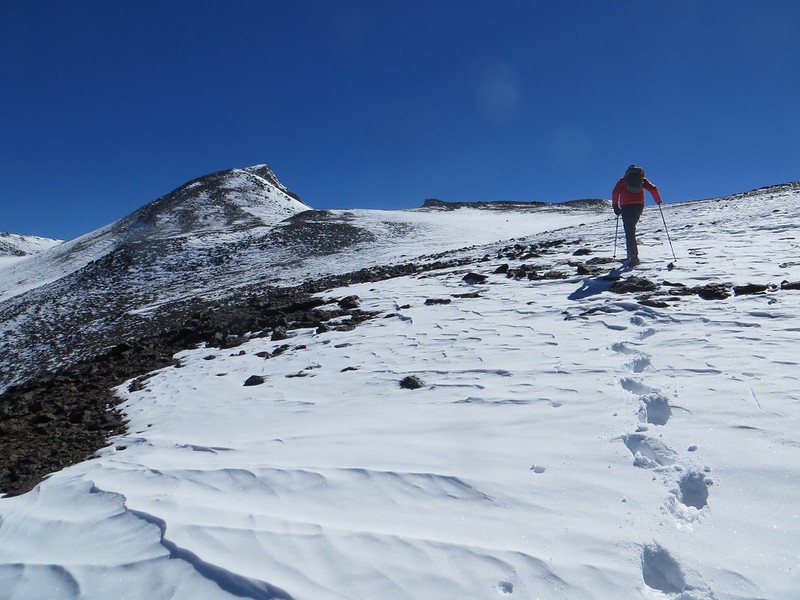
Above 6300m there’s plenty of snow, and as we’re tired from our bike push we climb pretty slowly. The 1050m from high camp to summit takes 4h45.

But the weather is excellent, and just after 11:00 we’re on the top. Veladero and Baboso are in the distance to the south.
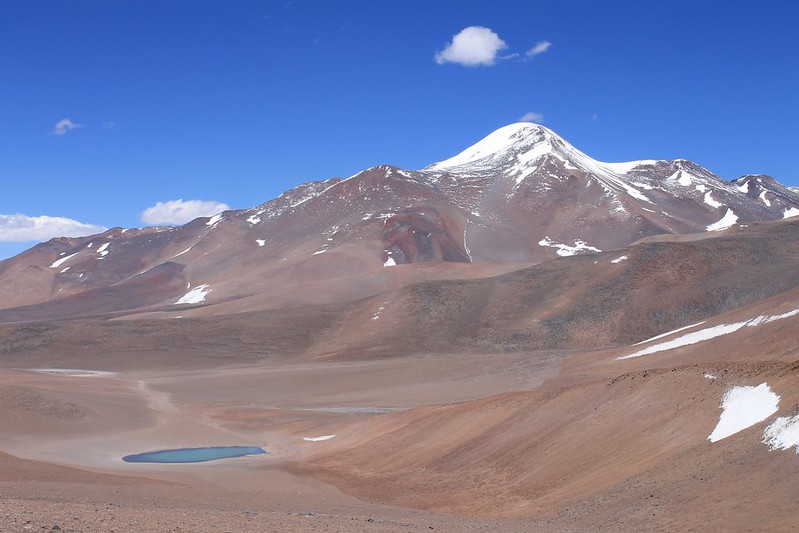
In the morning we set off to make a high camp on Veladero. The route we choose is a rubbish one, needlessly climbing over and crossing 3 ridges. We arrive at a 5200m camp in mid afternoon.
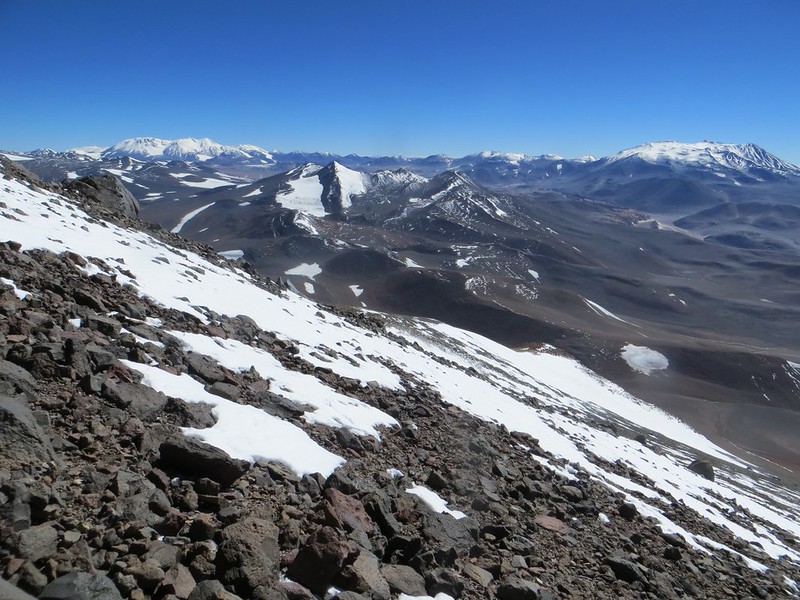
In the morning it’s windy, but we climb up the scree and rock slopes on the NE side of the mountain, which are protected from the icy westerlies. Camp is 1200m below the summit, but less than 3km away in a straight line. Constant 45-50% slopes make for a fast climb.
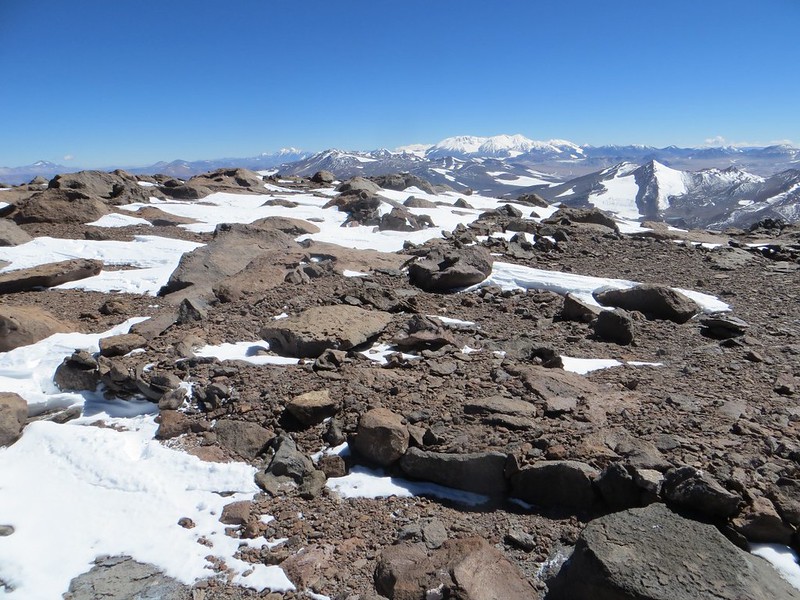
But it’s not a first ascent. Though rarely climbed these days, there were enough Inca ascents to build these ~12m x 12m walls up there.
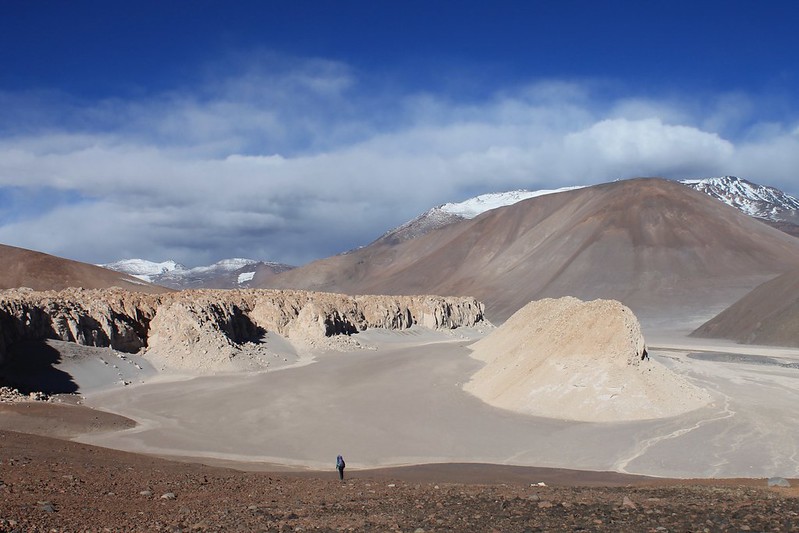
But it’s very pleasant, and we’re in good spirits, being pretty chuffed at having made it up to all our summits.

But south of Bonete the road is in good condition, and we can ride all the 23km down to the paving by Refugio Veladero.

In Fiambala we came across a cyclist who didn’t believe in prevailing winds, which we thought odd. Take this sign by Laguna Brava as an example. This is the east side of the sign…

We’ve cycled this section of the Pircas Negras road four times now, but that’s not such a bad thing.

But still we’re glad when we get back to civilization. Grido ice cream all round! Then it’s time for some bus madness to get back to Fiambala to rest a while and pick up some kit we’d left there.
[flickr_set id="72157640730430145"]
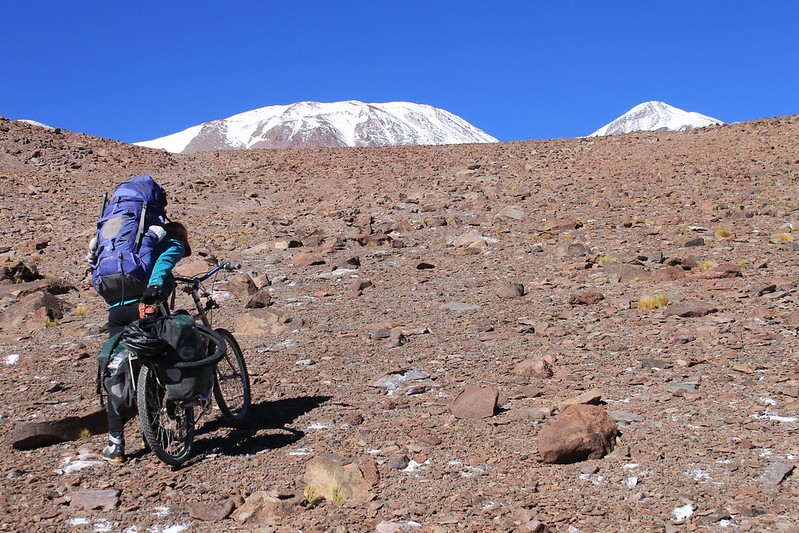

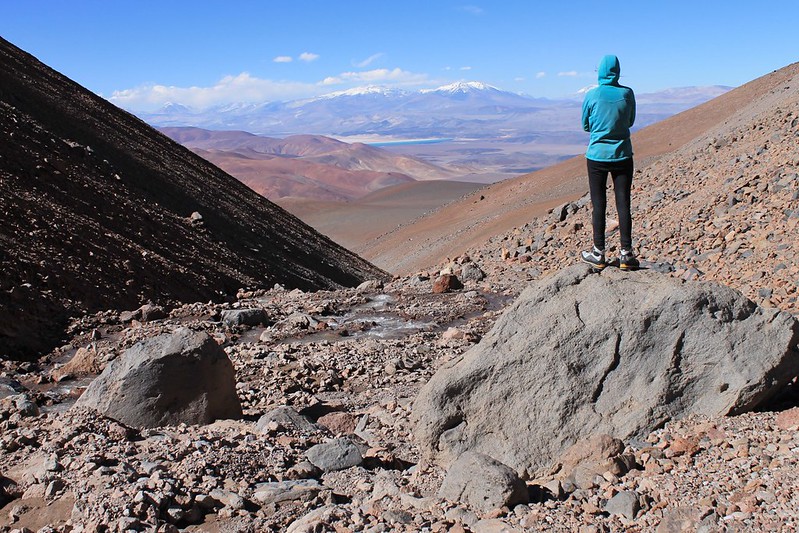

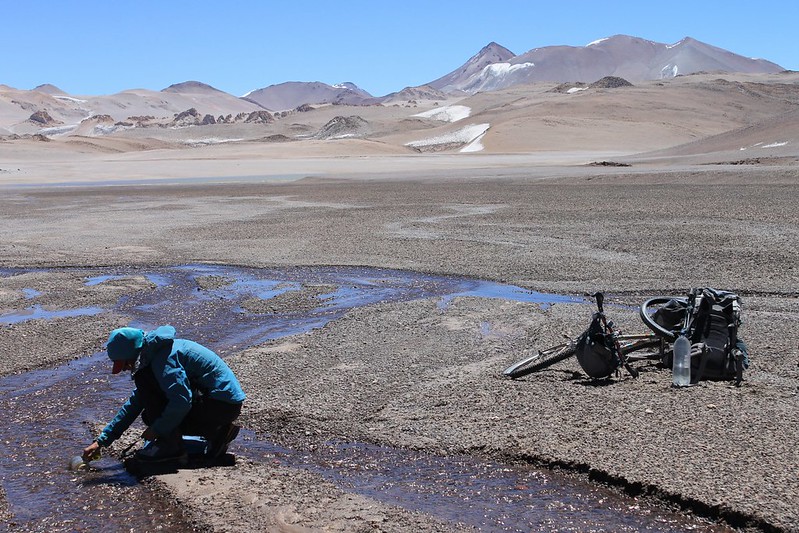





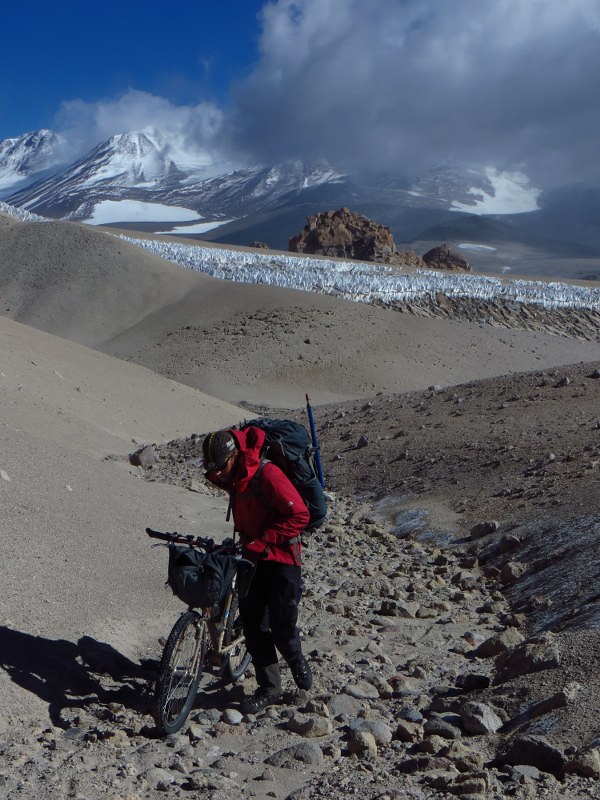
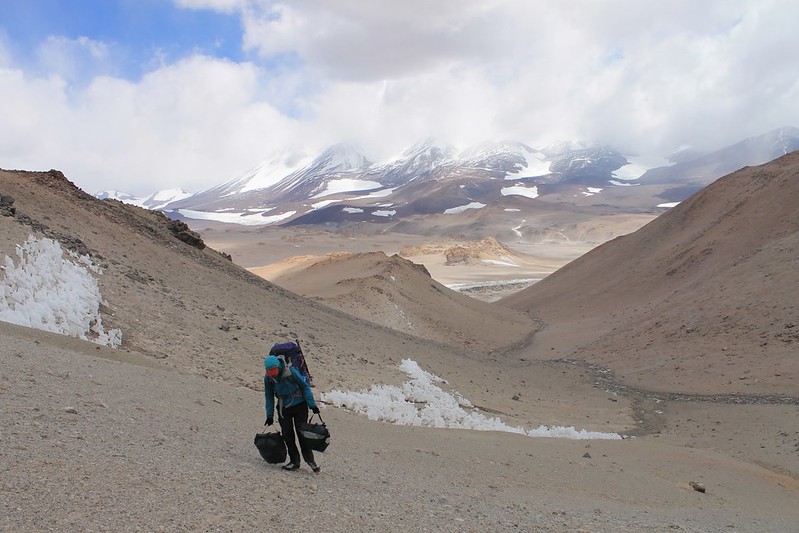


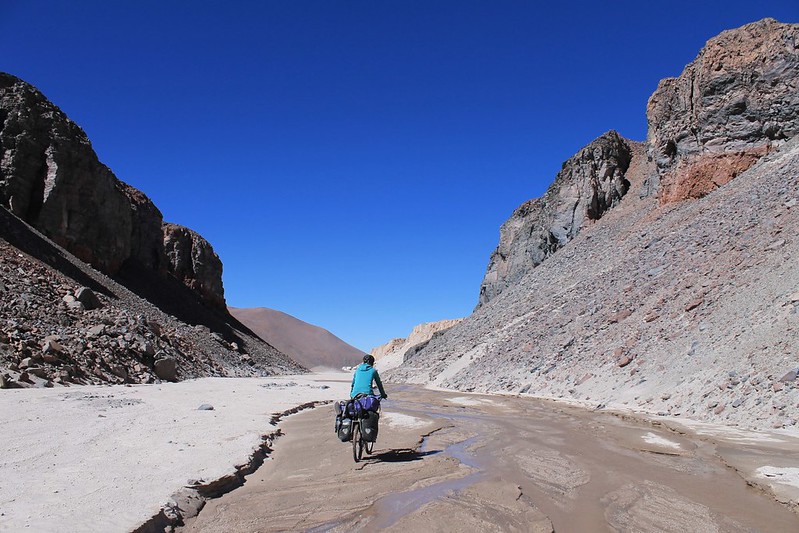
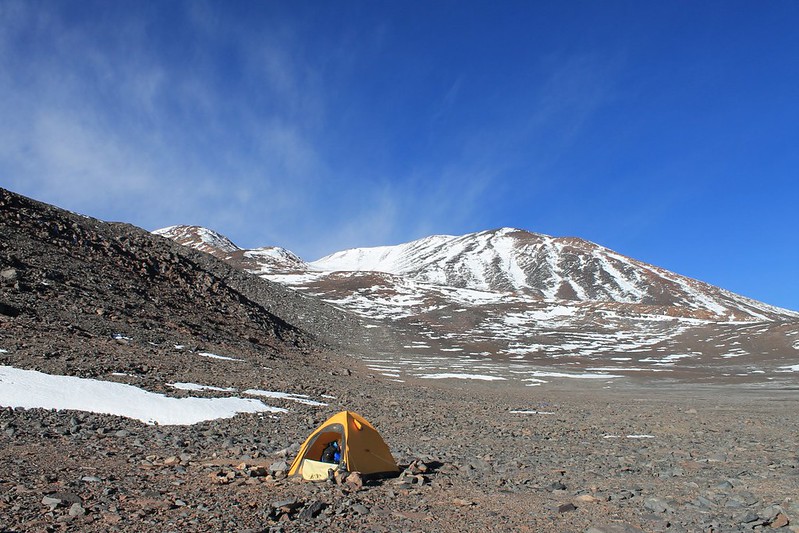

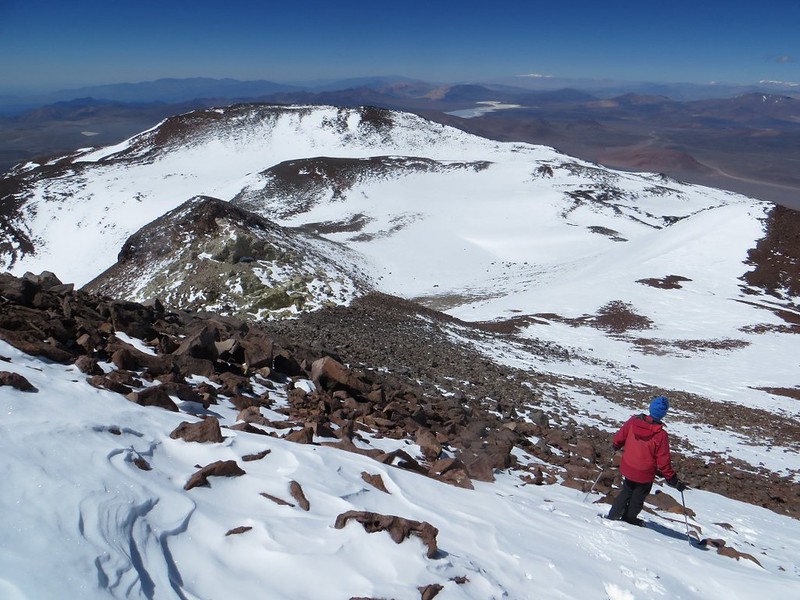

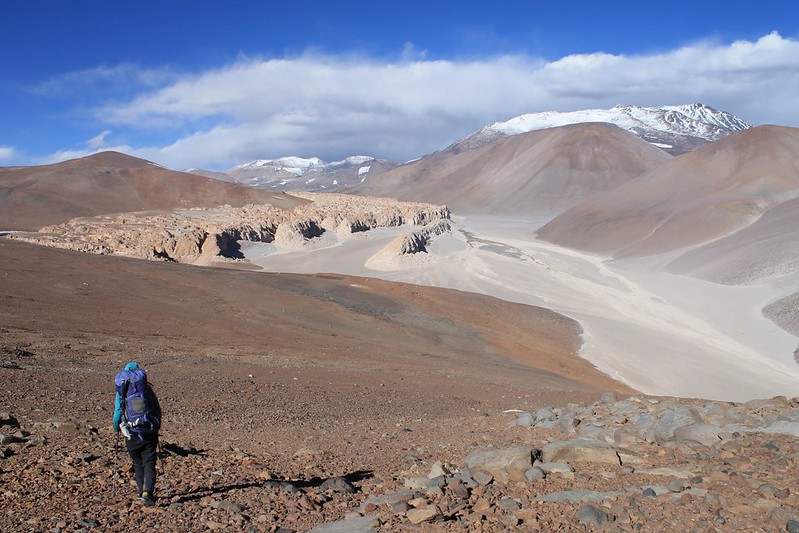
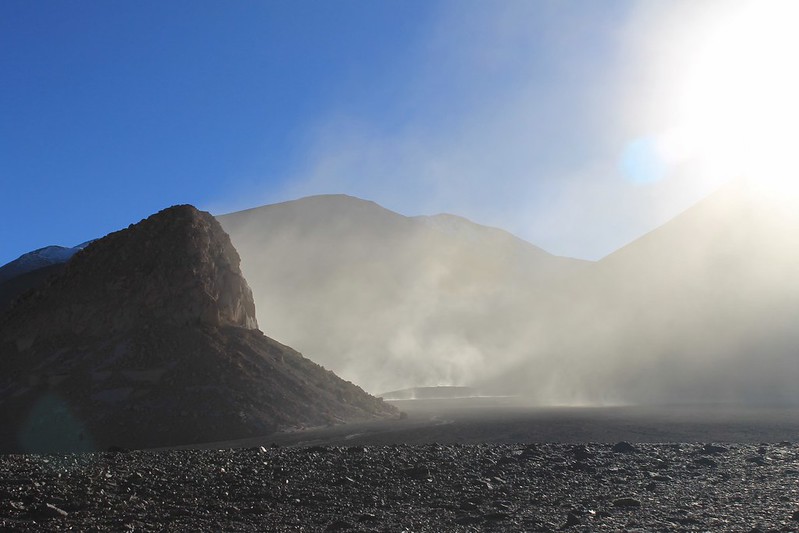
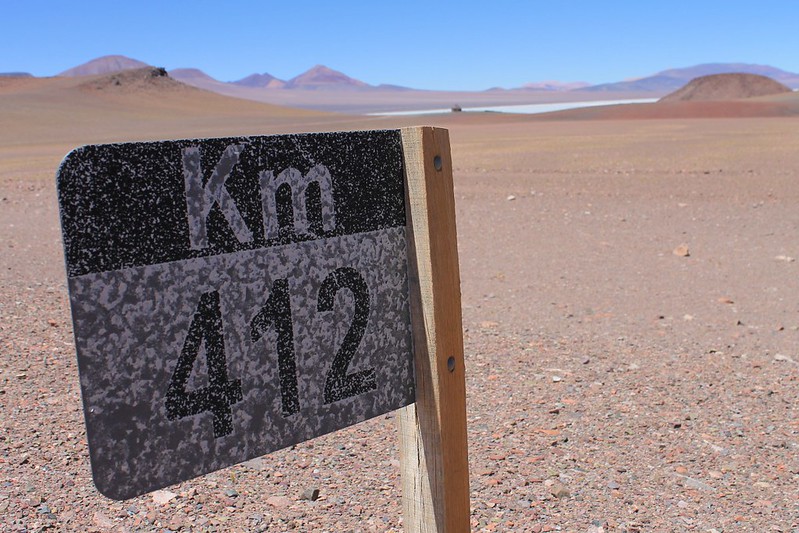


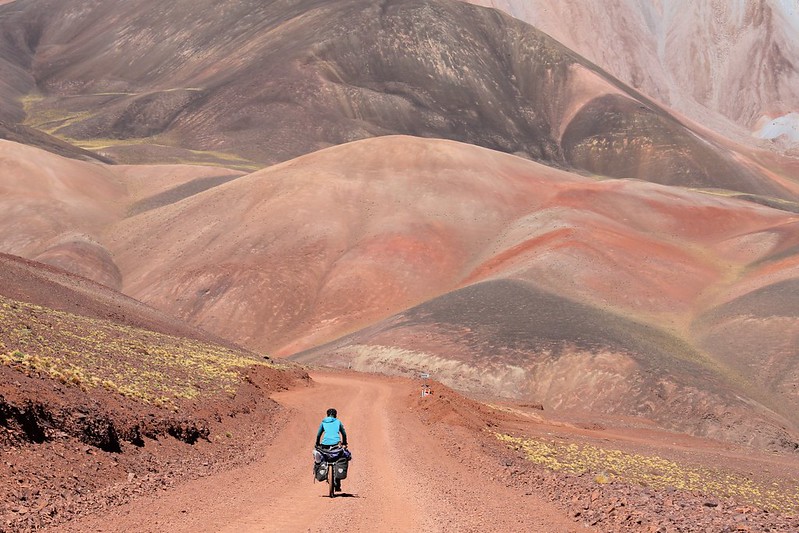
All 6400’s climbed, brilliant, well done. Stunning photos once again.
Cheers Bala! Yep, all done, so we need to come up with a new Andes project! Will keep you posted…
Congratulations: experience, perseverance and slowly pedal-powering your way to the peaks is the sure recipe for success! The 4×4 approach may be faster, but I think it also makes you weaker on the peaks.
I’m interested in the logistics of your 2011 El Arenal loop and 5-volcanos climb. How did you organize the trip? How much did it cost? And for the food and fuel, how much quantity was it per person per day? Did you arrange everything from Fiambala? Did the mules and handler follow you during the whole loop?
I know it’s a lot of questions, but I’d like to do approximately the same, replacing Ojos by the rarely climbed south face of Muerto and maybe throwing Olmedo into the mix. I’m planning it for one full month, as the acclimatization is very important, since once you’re in El Arenal, it’s difficult to exit in case of high-altitude problems…
Cheers!
Ides
Hi Ides,
Yep, I think biking to the peaks is the way forward. Much slower though! We tried to work out how quickly we could have climbed the 9 peaks in, had we had the services of a 4×4 and driver. I think we decided about 14 days if we’d really gone for it, as opposed to the 60+ it took us with the bikes!
We organized the 2011 El Arenal trip from Fiambala. Jonson found us the muleteer, who was with us for the first 2 1/2 days, to just before El Arenal. Can’t remember how much it cost, but it was more than we were expecting (U$300-U$500?)
We went with 21 days of food (though were back in 16) – probably had about 0.8kg per person per day. We took 6 small gas canisters, and used 4 (we didn’t have to melt any snow as there were streams everywhere we camped).
Sounds like a good plan you’ve got. Our original plan when we went into El Arenal was to climb Muerto and Olmedo too, but once we’d climbed Walter Penck it didnt seem worth it to climb Olmedo. And we never got round to Muerto…I think we decided it was too far away!
Every time I read this I get more excited by life. Put a fat-bike return to the Puna in your diaries for 2017.
And everyone knows prevailing winds are the mythical creation of weak riders.
Not really.
Ha! Yes, a fatbike would be good in these parts… A return is always on the cards – just need to decide which area of the Puna to focus on!
Having recently been in the area of Paso San Francisco with the bikes, we go back and read (once again) your Puna 9 adventure…and can only say it is really incredible what you did. Forget about driving precariously up to 5800 m like all the climbers we met do – biking to the base camp(s) with all that food and water is the way! We´d be happy if we ever manage a “Puna 1”. Maybe in 2015…!